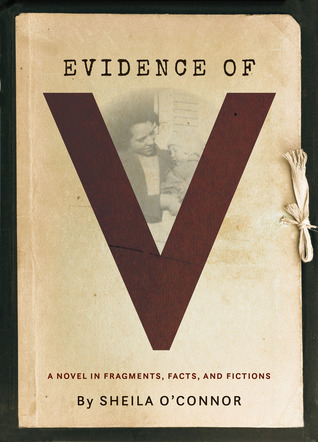
by Amanda Krupman
In Evidence of V, Sheila O’Connor excavates (and generates) a history of her maternal grandmother through collaged poetry, prose, historical documents, and memoir. In this effort, she approaches storytelling in a genre-defying tradition seen in works like Claudia Rankine’s Citizen, Carmen Maria Machado’s In the Dream House, and especially Maggie Nelson’s Jane: A Murder, in which the author constructs an imagined history for a lost family member.
[Where to start V’s story?
V at fifteen in 1935?
V sentenced until twenty-one, for what?
V the family secret I discovered at sixteen.
My mother’s missing mother never mentioned to me once. Shhh. The sound of V is silence.
Girl of sealed history like all those other girls. Sealed; therefore buried.
State documents I now excavate for answers. An official file of facts that read like fiction.
V a fiction built of fragments, as girls so often are.]
O’Connor’s novel differs significantly from Nelson’s work in that V—the first initial provided in historical documents in place of a name—is “absent and erased.” Neither O’Connor nor her mother has any memory of V, who lived in a detention home for girls (referred to as an “inmate” in the intake documents) from age 15 to 21 in the 1930s. There she gave birth to O’Connor’s mother, who was taken away from V as an infant and raised by her sister. Upon release from the center, V became estranged from her family and eventually disappeared into the memories of closemouthed aunts and uncles. So in the way many of us intimately know, trauma, slippery and often silent, was passed down through generations. O’Connor addresses this epigenetic function of inherited trauma directly in the beginning of the novel:
WHO: V, mother of my mother. Absent and erased. V, maternal grandmother. Both missing and maternal?
Mr. C, maternal grandfather?
June, born of V and Mr. C.
June, my mother not maternally inclined.WHAT: The mystery: My mother’s lost beginning. V unknown.
A fifteen-year-old girl.
Files unsealed by the county with permission from the court. Buried family facts unearthed.
Making sense of fact with fiction. Always fiction.WHEN: The Research: 2001 to present day.
The Story: 1935 to ad infinitum.
The length of time V’s cells transmit her trauma to us all: June’s children, and our children, and—
As in today: Call sibling in the psych ward.WHERE: Hennepin, Nicollet, LaSalle: Minneapolis streets named for explorers. (The men always explorers.)
The Cascade Club. The Belvedere Hotel.
Minnesota Home School for Girls, Sauk Centre, Minnesota.
Probation placement: Possibly Duluth?WHY: Because the truth was always missing. Because there is no truth.
Because June could not bond with her children. Because V was erased, a secret.
Because I need her to be gone.
Because I need to find her.
Because V leapt into traffic, a shock on someone’s windshield.
Because June lost V, lost her family’s story. Because we are living in V’s white space
where very little can be known.
O’Connor develops the character V in this white space. The central story that emerges functions mostly as a traditional narrative; O’Connor describes a willful teen, dreaming of stardom, living in near-poverty during Depression-Era Minnesota. This narrative begins with V performing on the street for change and then at a burlesque house, where she becomes infatuated with the owner of the club, Mr. C, who eventually impregnates her. She is sent off to a detention home with other pregnant teens, and O’Connor creates a sympathetic, longing portrait for a girl—one among many in her day—whose will and ambition are viewed as liabilities by her guardians, delinquent qualities that should be quashed with discipline—or, seen through contemporary eyes, abuse.
O’Connor doesn’t simply construct a historically accurate narrative in her depiction of V’s time in the detention home; she periodically interrupts the narrative to display evidence, including excerpts from handbooks written by directors of the juvenile homes. On one page near the end of the book, O’Connor reprints a section from the Handbook of American Institutions for Delinquent Juveniles, Vol. 1: West North Central States, 1938: “…Punishments—The various punishments include deprivation of privileges, confinement in a regular room, extra or unpleasant work assignments, corporeal punishment, cold tubbings, segregation, isolations, and delayed parole. Corporal punishment, in the form of slapping is permitted but not encouraged.”
She also calls attention to the formal constraints she has both imposed and disposed of in her work:
[TRUE OR FALSE]
1. T F The author is deliberately deceptive.
2. T F The author does not know the truth and so she lies.
3. T F The author trusts fiction over fact.
4. T F The author wants the truth, but knows she’ll never have it.
5. T F There is a truth the author knows, but she can’t tell.
6. T F The author was taught early not to tell.
Whether the average reader will find this synthesis of historical fiction, reportage, and memoir to dull or enhance one’s emotional investment in V’s (and O’Connor’s) story is an open question. I was deeply moved by Evidence of V, but I must confess to some partiality: my own maternal grandmother (who, unlike O’Connor, I knew quite well) was sent away to a girl’s home for some time. So I cannot separate my fascination with O’Connor’s project from my own vested interest in learning about that time of her life, kept secret from my mother (and, by extension, me) until after my grandmother’s death. As a writer of fiction, I too have toyed with drafts that center some imagined version of my grandmother as a teenager, filling in the blanks in an act of love, and it has proven to be a process that soothes, discomfits, muddles, uplifts, and overwhelms. I admire Evidence of V in the way an apprentice carpenter might admire an ornate cabinet—if the cabinet had been made by a member of one’s tribe, if in the intricacy of its details, it celebrated some shared signifiers of family.
In a rich period for autofiction and genre experiments, Evidence of V is a worthy offering for readers who appreciate these blends. It is also recommended reading for anyone studying the history of juvenile criminal justice and of women in the U.S., and those wanting to mine the instability of these histories, which O’Connor delivers in a poetic, affecting trauma narrative.
___________________________
 Amanda Krupman’s work has appeared in publications including Flapperhouse, The Forge Literary Magazine, BLOOM, The New Engagement, and Punk Planet. Amanda received an MFA in Fiction from The New School’s graduate writing program and was recently a recipient of a Jerome Foundation Emerging Artist Residency Award. She teaches writing at Pace University and “From Page to Podcast: Writing Audio Fiction” at Middlebury College. She is currently working on a collection of short fiction. Follow her on Twitter: @akrupman
Amanda Krupman’s work has appeared in publications including Flapperhouse, The Forge Literary Magazine, BLOOM, The New Engagement, and Punk Planet. Amanda received an MFA in Fiction from The New School’s graduate writing program and was recently a recipient of a Jerome Foundation Emerging Artist Residency Award. She teaches writing at Pace University and “From Page to Podcast: Writing Audio Fiction” at Middlebury College. She is currently working on a collection of short fiction. Follow her on Twitter: @akrupman

 The core workshop of SmokeLong Fitness is all in writing, so you can take part from anywhere at anytime. We are excited about creating a supportive, consistent and structured environment for flash writers to work on their craft in a community. We are thrilled and proud to say that our workshop participants have won, placed, or been listed in every major flash competition. Community works.
The core workshop of SmokeLong Fitness is all in writing, so you can take part from anywhere at anytime. We are excited about creating a supportive, consistent and structured environment for flash writers to work on their craft in a community. We are thrilled and proud to say that our workshop participants have won, placed, or been listed in every major flash competition. Community works.